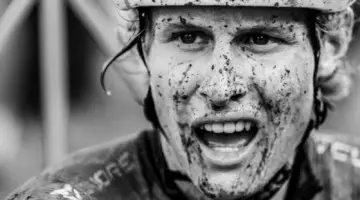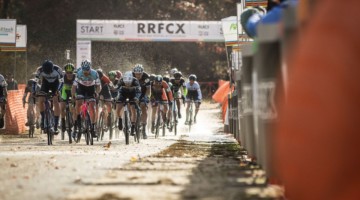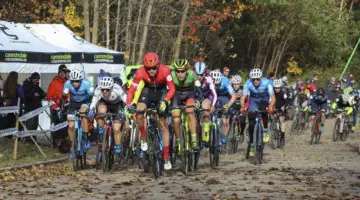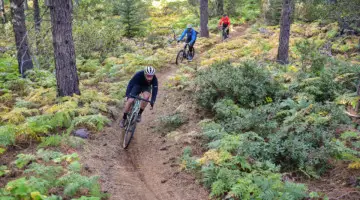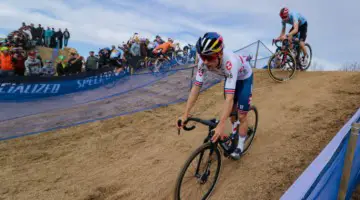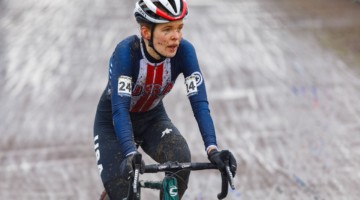On the Sunday of the 2017 U.S. Cyclocross Nationals, a lot was going on at Riverside Park in Hartford. An overnight snow blanketed the already frozen and rutted course and a cut cable imperiled the USA Cycling live stream of the day’s racing. After TV blackout during the first two races of the day, half the cameras were back up for the U23 Men’s race, but the second half of the course remained without cameras and largely unseen.
The half-seen U23 Men’s race that unfolded was the best of the week. In the last lap, Lance Haidet, Gage Hecht and Maxx Chance gave everything they have in a desperate battle for the lead. There were moments of high drama, individual daring and an improbable finish. It was everything beautiful about cyclocross.
Months later, Haidet, Hecht and Chance reflected on their incredible day in Hartford for this feature story.
With one lap to go, Maxx Chance and Gage Hecht had seemingly won the game of survivor in the U23 Men’s race at the 2017 Hartford National Championships. On a snowy, frozen, rutted course that had already claimed race favorite Curtis White, the two young riders had been the best at accomplishing the toughest task on that January afternoon: staying on their bikes.
After Hecht attacked and Chance countered with a gutsy pass on top of the iconic embankment, the two riders approached the exit from the wooded technical section wheel-to-wheel. It was there the two had an encounter that, at the time, seemed like the race-defining moment. Chance held the high line, while Hecht tried to come up an icy off-camber and grab the advantage. He was a second too late, and Chance took control of first while Hecht had to dismount from his bike.
“We both knew how important leading was on that course and that passing was really hard,” said Chance about their not-so-chance encounter. “After I opened my lead back up, I just put my head down and tried to make no mistakes for the last third of the lap and knew that if I rode smooth and didn’t make a mistake, I had a great chance of taking it.”
All that stood between Chance and the biggest win of his cyclocross career was a third of the snowy, icy, technical lap.
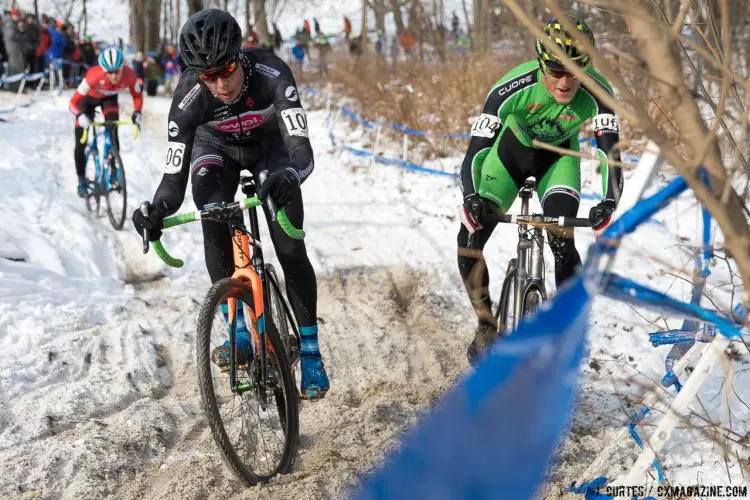
One of many key moments on the last lap of the U23 race, when Hecht ended up in the tape with just a half lap to go. 2017 Cyclocross National Championships. Sunday, U23 Men, Elite Women, Elite Men. © J. Curtes / Cyclocross Magazine
For folks watching at home, the “rubbing is racing” moment between Chance and Hecht would almost be the last they would see the race leader until just one hundred meters to go. A snowstorm had blanketed Hartford on Saturday night into Sunday morning, and when crews were plowing the course on race day, they cut the video cables for the back half of the circuit at Riverside Park. While Haidet, Chance and Hecht were giving everything they had in the last half lap, folks at home were left in the dark.
The last lap of the best race of the Hartford week would go half seen.
On the live stream, the camera focused on the rutted off-camber that would later claim Stephen Hyde’s rear derailleur hanger and nearly cost him his first National Championship. The first rider to come around the bumpy hill was … Lance Haidet. What had happened to Maxx Chance?
Shortly before the off-camber, with maybe two hundred meters to go for the U23 National Championship and out of sight of video coverage, Chance’s chain dropped. As he struggled to put it back on, the eventual winner Haidet and runner-up Hecht passed him.
Throughout the race, Haidet calmly worked his way through the field and was ready to capitalize when the opportunity arose. He passed the dismounted Chance and navigated the last two technical features. Surprising even himself, Lance Haidet was the new U23 Men’s National Champion.
“It’s so crazy looking back on it now that I won Nationals and led the race for literally like 20 seconds,” Haidet said. “When I finished the race, I really didn’t even know how to react.”
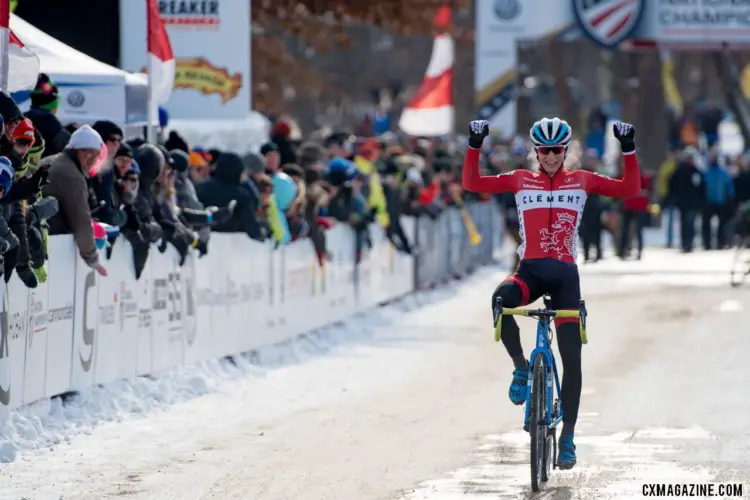
Lance Haidet wins a dramatic U23 men’s race. 2017 Cyclocross National Championships. © A. Yee / Cyclocross Magazine
Chance recovered to take third and at the finish line, he showed the poise of a champion giving an interview while holding back tears of what could have been.
Eleven months later, Chance was still able to show a little humor about that day in Hartford. “I don’t know if you saw it watching on the live stream but there was a polar bear in that corner that swatted off my chain,” he joked. And also some grace, “Lance rode a great race too and it was awesome to see him on the top step. I am stoked for him.”
The U23 Men’s race in Hartford was everything beautiful about the sport of cyclocross. The racing was intense, the conditions were insane and the drama heated up the cold January afternoon. The best race of the week in Hartford will be remembered for its moments, but the entire race was a test of both physical and mental mettle, with focus and a little bit of luck winning out over power and pizzaz.
Over the past six months, I have asked the three podium finishers from Hartford — Lance Haidet, Gage Hecht and Maxx Chance — to look back on the memorable race. Their responses are compiled here in an oral history of the best U.S. cyclocross race that went half-seen.
Great Expectations and Favorites
Heading into the Sunday of Nationals, the more anticipated of the two U23 races was the Women’s affair. Even Cyclocross Magazine helped hype up the last U23 battle between Ellen Noble and Emma White. With the two evenly matched all season — and basically their entire careers — it was fair to expect a memorable race from the two New England phenoms racing close to home.
The race between the two stars was a good one, and Noble was the stronger of the two on the snowy, icy, technical course. She took home the Stars-and-Stripes in solo fashion in her last Nationals race as a U23 rider.
On the Men’s side, Emma’s brother Curtis came in as the favorite. The elder White had finished second behind Tobin Ortenblad in Asheville the previous year, won the 2016 U23 Pan-American Championships and the Vittoria Series and rode near the top ten in Europe during the December block of EuroCrossCamp. There was a sense that White was not only the man to beat, but also the odds-on favorite.
“Oh for sure,” Chance said when asked if White was the favorite. “Curtis was the heavy favorite and I was expecting him to ride away with it as he had been crushing it all season leading into the event. I was hoping to win the race since it is Nationals after all and you can’t toe the line without at least the hope of winning. For me, I think the goal was the podium.”
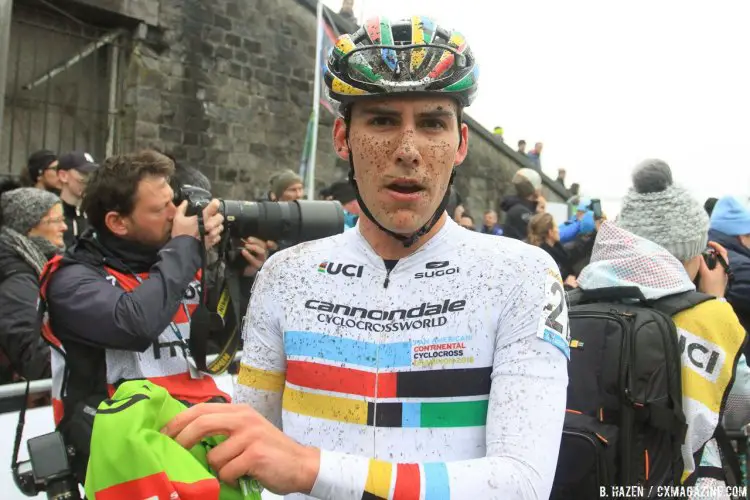
U23 Pan-American Champion Curtis White entered the race in Hartford as the favorite.. 2016 Namur Cyclocross World Cup, U23 Men. © B. Hazen / Cyclocross Magazine
Haidet knew that the conditions would play a role in the race and that being the favorite was not the best place to be on that Sunday. “Going into the race, I think everyone expected if Curtis had a perfect race he was probably going to win. Going into that course with the conditions, there was certainly room for error. Especially in Curtis’ position knowing he was probably the one who should win based on past results and the season thus far, that’s a lot of pressure to put on yourself.”
For the then-Clement rider, just getting to the start line feeling healthy was a small victory in itself. The injuries that plagued his season could not have been too far from his mind with the treacherous conditions that awaited.
“Going into the race I had back issues all season and struggled with them and wasn’t able to get the results I thought I was capable of. With the help of my team and my coach and my friends, and most importantly my family, the whole season I kept my head down and stuck to the plan and pushed through it. Lining up for Nationals on that day, I didn’t know what to expect. It was the first time in years I didn’t line up on the front line at Nationals, [because of my] not-so-stellar results during the season.”
The Game of Survivor Begins
The first half of the lap in Hartford was dominated by the Bonk Breaker hill that sat along a steep Riverside Park embankment about one minute into the lap. In theory, the section had an infinite number of lines, with the course tape placed at the very bottom and top of the embankment. However, early in the week, two general lines emerged and with the snow and ice on Sunday, there were two and only two choices.
One was to run up diagonally and try to ride along an inches-wide path at the top of the embankment. The other was to start riding low and then climb diagonally toward the exit. The line of choice for most racers was to run then ride, but some enterprising athletes did opt for the low riding line. In the U23 race, most of the fast starters went high and Cooper Willsey was all alone riding the low line. He was rewarded with an early lead when Peter Goguen slipped at the top of the embankment.
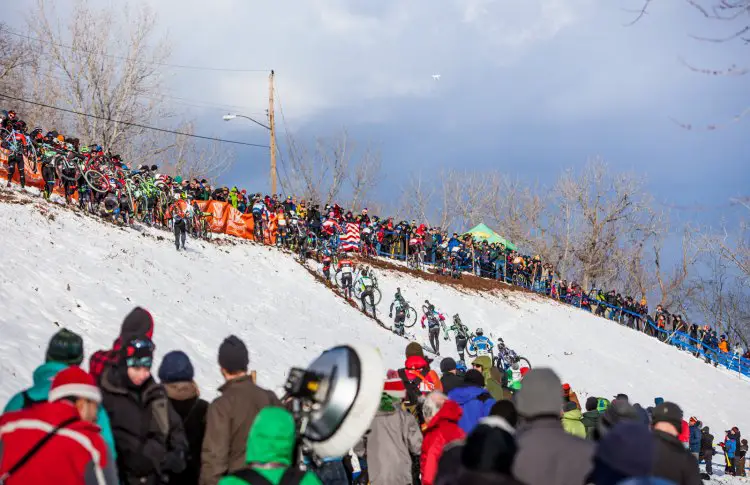
On Sunday, racers had the option to run then ride or ride then run. 2017 Cyclocross National Championships, © D. Perker / Cyclocross Magazine
“I remember the first lap, I was really happy with the start I had,” said Hecht. “I got the holeshot and then Peter Goguen led up the run-up. Cooper ended up taking the lower line and we went to the top. The combination of the adrenaline and the race nerves, I think, Peter ended up sliding down the hill a bit. Curtis and I got stuck behind him and Cooper got like a 30-second lead on us.”
Any doubts about his legs that Haidet had were quickly erased. “The race went off and I definitely felt good. My legs felt good, the line choices I made felt good. I unfortunately had two flats early in the race, but each time I was able to move up quickly. It was just one of those days that I felt good on the bike and was able to stay calm and collected even when I bobbled or had a flat tire or made a little error. I never really got down on myself at all. It was really just like recollect it and move back up, move back up.”
Chance echoed similar sentiments. On a course like the one in Hartford, you almost have to have a good start to be in a position to finish on the podium. “I was mostly focused on riding smoothly and making the least mistakes I could during the race. I made sure to take my time on the corners and stay upright rather than rip the corners and slid out. I had a great start and was able to get clear of the first lap traffic and settled into my rhythm on the course. I managed to keep it close to the leaders on the first lap and catch up with them on the run-up. Once I was up there I just tried to stay upright and be in front so I could choose my own lines and not get slowed down by the crashes.”
After one lap, Willsey still held the lead after his early gap, but Hecht and White were charging hard. Chance was in a solo fourth and Haidet was back in sixth.
Go Hard, Stay Upright
Fans tuning in to watch the racing on Sunday saw a course covered by a nice layer of white snow. From afar, perhaps it looked like fun conditions for riding a cyclocross bike. On the ground in Hartford, however, a week’s worth of hidden dangers remained hidden beneath the veneer of packed snow.
The weather the prior week had brought a witch’s brew of conditions. Before the championship races started, a rainstorm hit Hartford while temperatures hovered in the 40s. Riders in the non-championship races on Tuesday were treated to a course that turned into a literal slip ‘n slide in places.
Chance had the opportunity to race earlier in the week in the Collegiate Club race on Wednesday, but when he toed the line on Sunday, it probably did not matter. Chance and his peers racing on Wednesday slashed ruts into the soft ground and then the ruts summarily froze when temperatures dropped on Thursday. Saturday brought snow to add to the treacherous landscape.
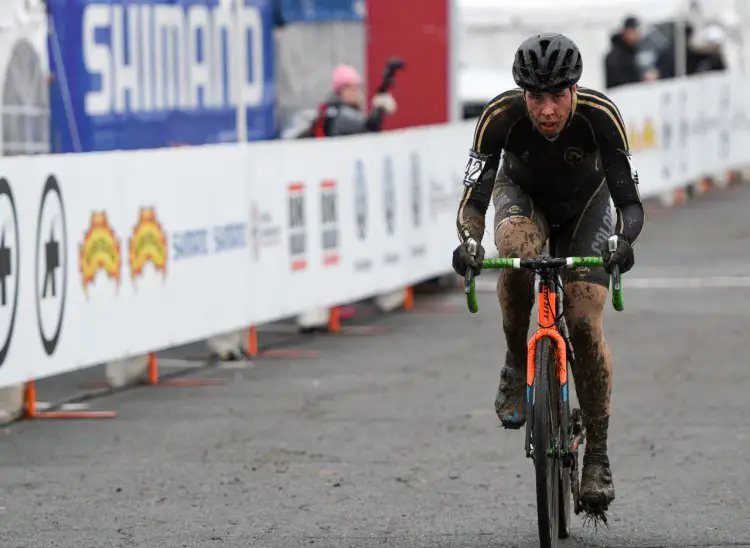
Maxx Chance won the Collegiate Club title in much different conditions earlier in the week. 2017 CX National Championships Hartford Day 2 Collegiate Men Club. © A. Yee / Cyclocross Magazine
Masters riders who had to navigate the frozen landscape earlier in the week repeatedly commented on how the conditions made it really hard to make up ground and that staying on the bike was of utmost import. On Sunday, those conditions were magnified by the snow.
“I think the weather was the single biggest competitor in the whole race,” said Chance. “When you are racing in those conditions you have to dress warm enough that you don’t lose feeling in your hands, but also wear gloves thin enough that you have control of your bike. Not to mention that most of the corners were ice rinks or frozen ruts. Also racing on snow and ice is a completely different skill set than mud or other conditions. It takes a lot of patience and finesse and a bit less raw power. I think that growing up ripping my bike around Boulder in the winter definitely prepared me well for the conditions.”
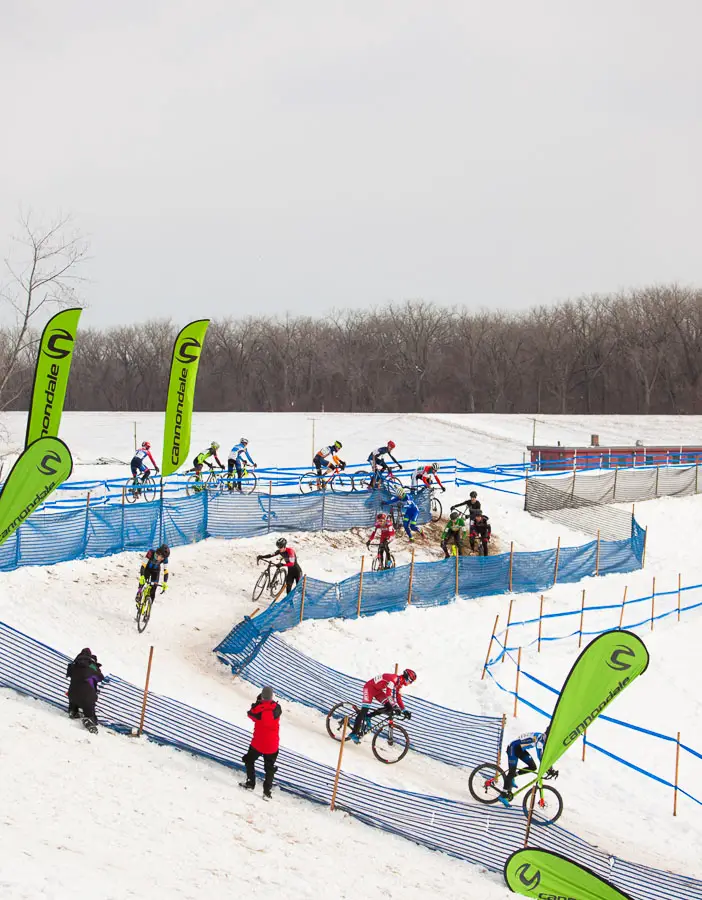
Riders said the conditions were the toughest competitor on that January day. 2017 Cyclocross National Championships, © D. Perker / Cyclocross Magazine
Echoing what he said earlier, Haidet was focused on not letting the conditions beat him. “Going into the race with the conditions and the snow and the ruts under the snow, ultimately it was going to come down to who made the fewest errors. I knew when everyone started getting tired, those errors would only increase and become more costly.”
Hecht said tactics were pretty much thrown out the window due to the conditions. For him, the non-tactical nature of the racing would become important in due time. “The thing with that race was there wasn’t really a lot of tactics to it. It was more going as hard as you can and staying stable while doing it.” He continued, “It was go hard, stay upright, go hard, stay upright. That was the only thing everyone was thinking the entire race.”
A Crash Shakes Things Up
Two laps in the lead group was White, Chance and Hecht. At this point, it was by no means a selection. In fact, there would be no selection on that day. Anyone in the top six or seven had a shot at winning.
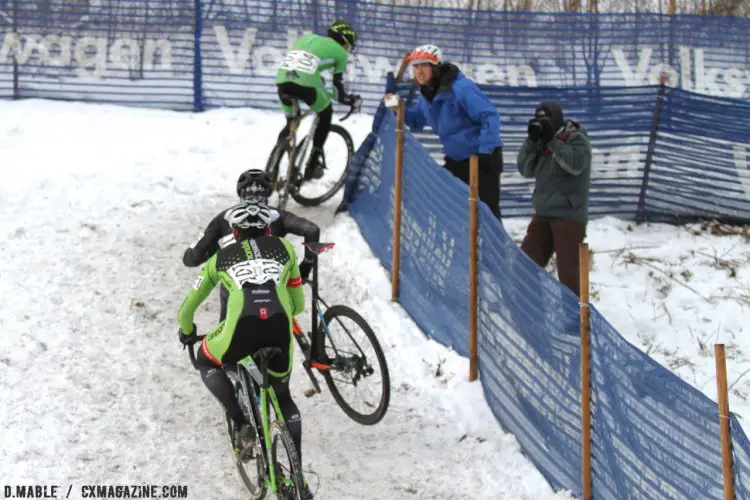
Early on, the leaders were Gage Hecht, Maxx Chance and Curtis White. 2017 Cyclocross National Championships – U23 Men. © D. Mable / Cyclocross Magazine
Hecht was racing in his first U23 race after an impressive Junior career where he won Nationals six times. He was also one of the more successful U.S. Juniors in recent memory, winning the Koksijde World Cup in 2014 and finishing fourth at Worlds in 2015. Fifteen minutes into the race, he was showing he was not afraid to ride aggressively at the next level.
Despite being unquestionably one of the top young cyclocross riders in the U.S., Curtis White had never won Nationals. All the way back to 2006 when he was racing age 12, White was stuck with the unfortunate curse of being the same age as Logan Owen, who joined Hecht as another successful American Junior. Owen won U.S. Cyclocross Nationals nine times as a Junior and U23 rider. The only two riders to beat him at the event? Jeremy Powers and Stephen Hyde at the 2016 Elite Nationals in Hartford. When Owen moved up to race the Elite race in Asheville, White then ran into an on-form Tobin Ortenblad.
As Haidet said, the race in Hartford was White’s to win, but with the conditions, nothing was a foregone conclusion. In an interview with Cyclocross Magazine last January, White said the title was something he wanted pretty badly. “I try not to put pressure on it, but I’ve never won a National Championship. I won a lot of races but never Nationals and it was always something that I really, really wanted. This was my last year in the Under 23, I felt like it was my year, but I think the movement with the young guys, it’s something the U.S. hasn’t seen before.”
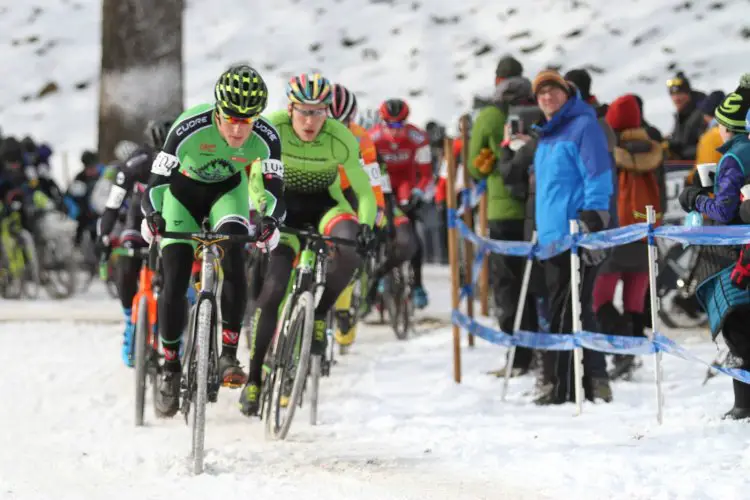
Curtis White had a good start and through three laps was where he wanted to be. 2017 Cyclocross National Championships – U23 Men. © Cyclocross Magazine
Three laps into the race, White was where he needed to be. It was him, Hecht and Chance at the front. Then the fateful fourth lap happened.
The first real corner of the lap was a slightly downhill sweeping left-hand turn that led to Bonk Breaker hill. Located right after a long straight past pit one, the corner was the sight of frequent carnage during the Masters races earlier in the week. Even Adam Myerson’s Masters 45-49 winning ride was almost ended by a first-lap crash that took out many riders during his race.
Sitting second, White lost traction in the corner and went down. With Stu Thorne right there to coach him, White recovered and all was not lost. However, Hecht and Chance did open a gap. Earlier, the riders talked about they were battling the course more than each other. As we will see in the race’s closing laps, battling the course on this afternoon was proved to be a fool’s errand.
Visibly pressing to make up time, White went down again entering the woods. This time, the recovery was not as quick.
“I crashed early on and I let myself get way too frustrated,” White said. “It was a course that really rewarded you for staying as calm as possible which it’s kind of silly to say, but I raced it more like an amateur and just went balls to the wall and crazy from turn to turn trying to catch up and that was just really destructive. It just caught up to me in the end and then the last two laps, there was just no way I could have brought the gap back.”
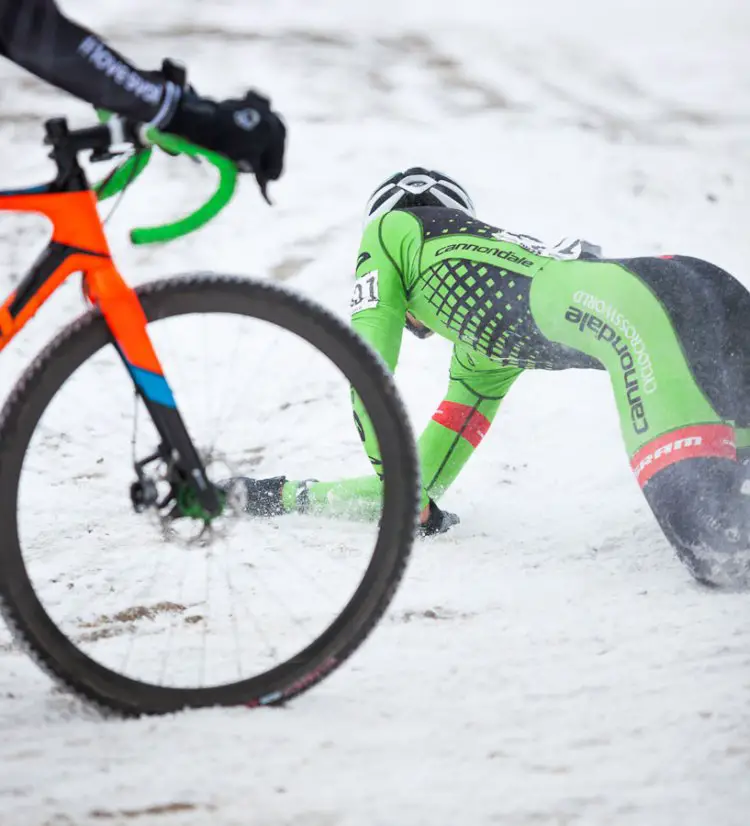
Curtis White had a tough afternoon including this crash. 2017 Cyclocross National Championships, © D. Perker / Cyclocross Magazine
The other riders took note of White’s crash. There is no question they respected his abilities and the stature he carried in the field. Up to that point, Haidet was riding steady, but he had not yet made his way into the conversation at the front of the race. Still, passing White was a big moment for him.
“Maxx, Gage and Curtis were the leaders for most of the race until Curtis had his crash,” he said. “Once he crashed, it took me a little while to pass him because I was in sixth or whatever. When I passed Curtis I definitely knew there was a chance I could win. That took out one guy who would be really hard to beat if something didn’t go wrong. It was definitely a bit of motivation to try to get to the front now that there was an even better chance that winning was possible. In the race, I definitely felt that when I passed him and I think other guys felt that way too.”
There was a caveat though. Said Haidet, “The funny thing about that course was yeah, he did crash and went back five or six places, but the possibility of you doing the exact same thing was pretty darn high. It’s wasn’t ‘Oh, the race is totally over because Curtis crashed,’ because any second you could do the exact same thing.”
Chance agreed with Haidet, “I mean he was the odds-on favorite and seemed to be struggling on the ice, so it gave me a confidence boost to know that he was struggling to ride the ice. But it also reminded me to try and stay upright and ride smoothly.”
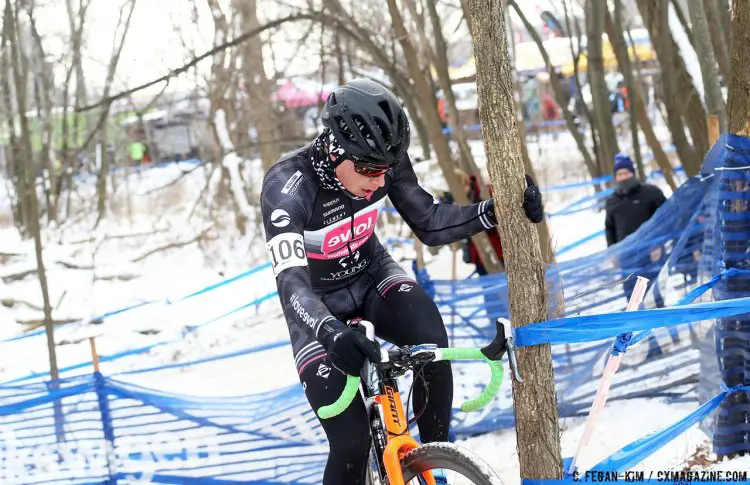
On the icy course, Maxx Chance was willing to look to anything for an advantage. 2017 Cyclocross National Championship. © C. Fegan-Kim / Cyclocross Magazine
Hecht, however, disagreed with his fellow competitors. “I think on any other day, if it was more of a grassy race like Cincy or Louisville, where there was more tactics to it, the race definitely would have changed. It would have kicked up a lot faster as soon as everybody realized that Curtis was down, everybody would have started looking at each other. But in that race, I don’t think there was really any time for anyone to react to it.”
With three laps to go it was Maxx Chance, then Gage Hecht, then Lance Haidet.
Slow and Steady Gets Back in the Race
After surviving two early flats, Haidet had finally made his presence felt in the racing. Looking back, it is easy to watch the replay and say, hey, there’s Lance Haidet, but at the time, he had yet to be a factor in the racing. Unlike some of the other big names at the front, Haidet was still looking for the kind of success that Hecht and White had experienced at Nationals and throughout the season. Although he had raced Nationals for years, Haidet had not been on a National podium in a long time when he headed to Hartford.
On that day though, Haidet was committed to staying focused and error-free, even though he had some struggles early on. “There was a point where I was like 40 seconds down from the leaders. It was crazy. The whole race it was ‘Ok, I’m in sixth, to fifth’ then I got a flat tire and went into the pit that wasn’t plowed, so I was riding through snow seven inches deep and lost another 20 seconds. And it’s like ‘Okay, awesome, let’s move back up.’ It was truly a race of keeping your head down and going for it.”
Haidet hails from San Luis Obispo located in Northern California, so he certainly did not have a natural advantage in the snow. Regardless, his technical skills were right at home on the snowy, icy course.
“I felt like the one part of the course I had dialed was the twisty section in the trees after pit two. Every lap I felt like I could make up five seconds just in that one section. I’m not sure what it was, whether it was line choice or awesome tire pressure for riding on ice, but I felt really good in that section. It was literally every little corner, just making up incremental amounts of time. I felt really confident on the bike and with my handling that day.”
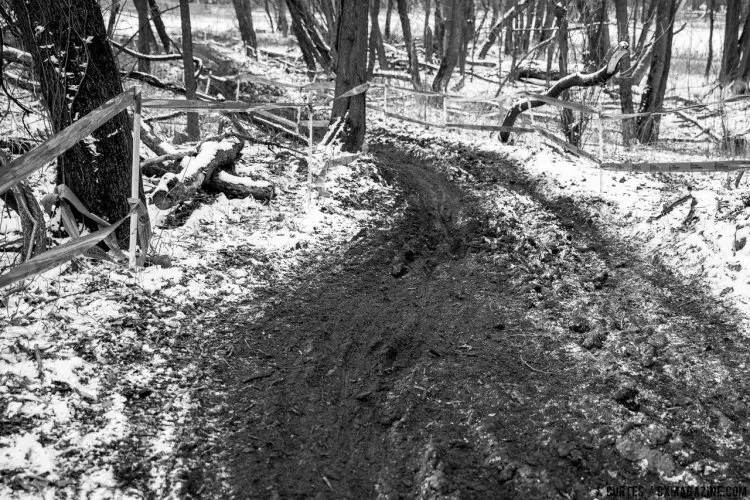
One bad line through the trees could spell disaster, but Haidet had the section dialed in. 2017 Cyclocross National Championships. Sunday, U23 Men, Elite Women, Elite Men. © J. Curtes / Cyclocross Magazine
Hecht took notice of Haidet’s riding. “Lance had like the coolest race ever out there. If you watch him in the first lap I don’t even think I saw him very much on the live feed. You don’t really see him come into view until two laps to go when he’s sitting around fifth place. Then with one lap to go, he’s in the top group of three. Lance was kind of slow and steady wins the race. I don’t think I ever saw him have any big problems. He just kept it smooth and steady the entire race, which is really cool to watch when I look back on it.”
While Haidet was steadily making his way back to the front, Hecht was going through emotional tumult. “It was kind of a roller coaster,” he said. “It went from ‘Hey, I’ve got a good chance to win this,’ to ‘Oh crap, I hope I make the top five now.’ Every lap there was a constant change in how I felt about it.”
He continued, “I remember later in the race getting to the point where I was off the front by maybe 15 or 20 seconds and I was so excited to be in the position I was. I was like ‘Hey, if I just stay careful and do well with this, there could be a gold medal waiting for me,’ and then maybe five corners later I went down, which was kind of expected. It was constantly having to pick yourself off the ground and then getting back to the front and then figuring out you’re off the front.”
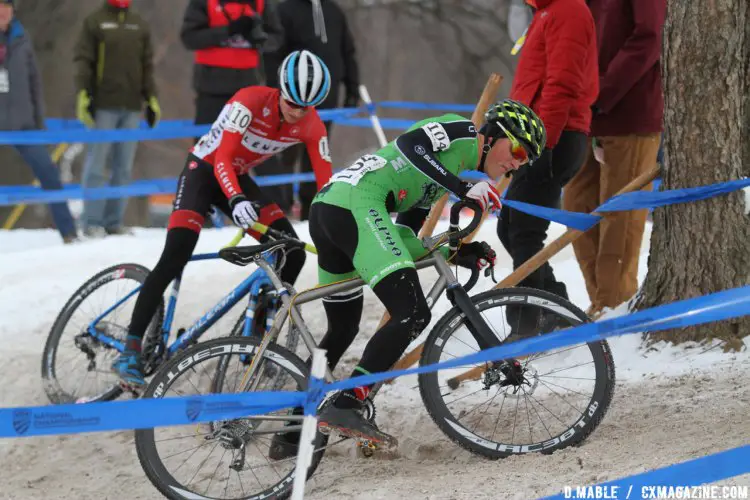
Even when Hecht felt good, trouble was just around the next corner. 2017 Cyclocross National Championships – U23 Men. © D. Mable / Cyclocross Magazine
Rubbing is Racing
At the bell, Hecht had a pretty good idea he was at the front. Why? Because Chance was right there with him. The two ripped their way through the start/finish straight and Haidet followed by ten seconds. Behind Haidet was Hecht’s teammate Brannan Fix. This group would make up the top four, but the rider at the front would change several times.
The two leaders battled past the pits and then Hecht attacked to take the lead heading up Bonk Breaker hill. With Haidet and Fix lurking close behind, there would be no easy win. At the same time, the course was daring riders to push just a little too hard so it could rear its ugly head once again.
On top of the embankment, Chance made what can only be described as a gutsy pass. As Hecht tried to put his bike down to hop on, Chance seized the moment to drop on the steep side slope and sprint past him. One slip could have sent Chance tumbling down the embankment and off the podium. As it was, he was now in first.
“We both knew how important leading was on that course and that passing was really hard,” he said.
Hecht attacked. Chance attacked. It was clear not an inch would be given without a fight.
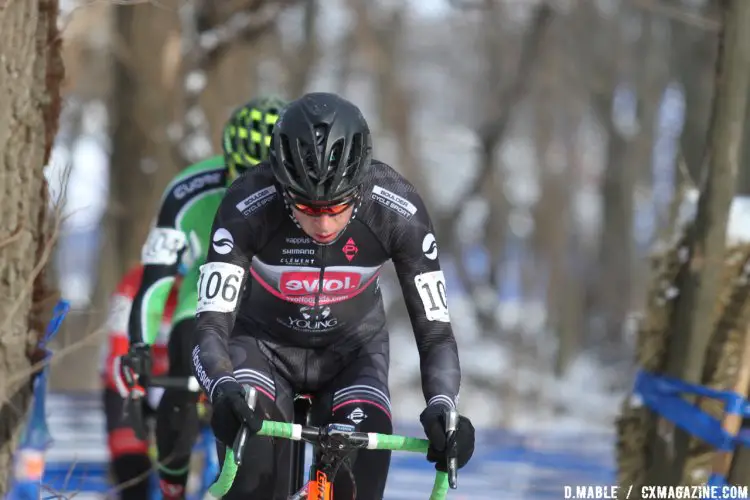
Maxx Chance and Gage Hecht took their last-lap battle into the woods. 2017 Cyclocross National Championships – U23 Men. © D. Mable / Cyclocross Magazine
“I was getting really excited because I knew even though I don’t typically want to lead into a sprint because it’s a little more risky, on that course it was definitely more advantageous to be first wheel so you don’t get caught up behind first wheel if he crashes,” said Hecht about their attacks. “If you’re first and the guy behind you goes down, you automatically get a gap. I was definitely trying to get up to that first wheel and I know Maxx was trying to protect his position.”
After riders dropped off the embankment and the levee located in the far side of the course, they passed through a deceptively technical section through the woods and headed back toward the boathouse. The section featured a variety of off-cambers and the ruts from earlier in the week made the trip harrowing at high speeds. Coming out of the last corner in the woods, Hecht and Chance were wheel-to-wheel. Literally right next to each other.
Unfortunately for one of them, the exit from the section only had room for one. Chance held the high line while Hecht was on the lower trajectory and would have to beat Chance to the exit. Hecht was a second too late.
“As I was trying to come around him on his left, he held his line pretty sternly and put me in a place where I had to fight him to come up away from that tree,” said Hecht. “We do that with each other, we’re pretty aggressive against one another, which is a good skill to have heading to Europe. I just never ended up getting enough traction on the ice and everything to be able to come up into him. I had to bail with the tape right there. That was a bummer to not be able to come up and possibly take the front or even just stay on my bike. It’s part of racing.”
Chance was now in a solo first position and Haidet passed Hecht to take over second. All that remained was about a third of a lap through the technical turny section around the gazebo and the last two technical features. “After I opened my lead back up, I just put my head down and tried to make no mistakes for the last third of the lap and knew that if I rode smooth and didn’t make a mistake, I had a great chance of taking it,” said Chance about his chances after the run-in with Hecht.
A Few Hundred Meters of Mayhem
Shortly after Chance and Haidet passed the gazebo, they disappeared from view on the live stream. After Saturday night’s snow, the course needed to be cleared for Sunday’s racing. In the process of clearing the course, one of the plows clipped one of the video cables on the back side of the course near the gazebo. The live stream for the Junior Men’s and Women’s U23 races was knocked off-line, and it had only been restored shortly before the Men’s U23 race. Still, the back side of the course was dark. The three young riders were desperately giving it everything they had and no one at home could see.
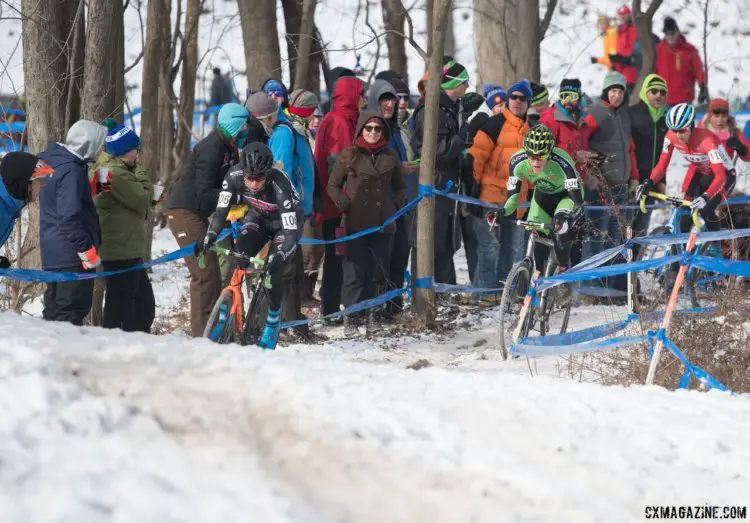
The three leaders battled for position in the blacked-out back half of the course. 2017 Cyclocross National Championships. © A. Yee / Cyclocross Magazine
The last few hundred meters of the course had a left-hand turn and then two obvious technical features. The first technical feature was an off-camber on a small mound that had become bombed out throughout the week. It was this feature where Stephen Hyde would crash and smash his derailleur hanger an hour later. Riders then had to blast up an incline and navigate an off-camber descent before reaching the finishing straight.
After nearly 50 minutes of wild, unpredictable racing, it is only fitting it was the seemingly mundane left-hand corner that had the ultimate say in the Men’s U23 race.
Sitting in the lead and not yet in the live stream picture, Chance’s chain dropped as he came around the turn. He dismounted and tried to get it back online. Haidet and Hecht passed him and Brannan Fix was coming up fast. Chance went from winning to potentially falling off the podium.
Situated at the boathouse down by the river, commentators Georgia Gould, Tim Johnson and Brad Sohner were limited by the lack of video coverage as well. Looking out across Riverside Park from the boathouse, Johnson noticed Chance’s chain had dropped, but amid the confusion the team faced, it was a subdued commentary that did not match the gravity of the situation.
Chance was three corners away from a national championship. It was an utterly devastating moment for a young rider who had done everything right and fought his heart out for the entire race. Cyclocross can be so cruel even to class acts like Maxx Chance.
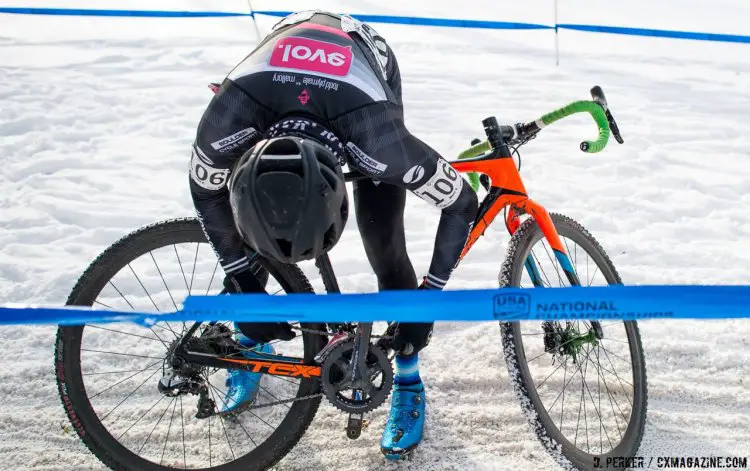
A dropped chain near the finish line cost Maxx Chance his title dream. 2017 Cyclocross National Championships, © D. Perker / Cyclocross Magazine
Nearly a year later, Chance had a good sense of humor about the incident. “I don’t know if you saw it watching on the live stream but there was a polar bear in that corner that swatted off my chain. So I not only had to put my chain back on, but I also had to fight it off so it couldn’t attack anyone else! You’re welcome, world.” He continued, “Also, my chainring bolts were loose … and the bear thing, mostly the bear thing.”
Once Chance recovered, the gravity of the moment finally hit him. “I was freaking out and just tried to get my chain back on as fast as I could and get to the finish line. Ironically, the first time it really hit me that I was going to win was when it all went wrong and I was standing there as Lance and Gage passed me.”
Chance was able to recover and outsprint Brannan Fix to take third. After finishing, Chance again showed his class by talking to our Cyclocross Magazine team about the race. Far more accomplished racers who are paid much more have refused such interviews on days that were much less awful than the one Chance had in Hartford.
With time gone by, I asked Chance how he views the race now. “That race was the best and worse race of my life,” he said. “I was riding better than I had ever ridden before, and then a few loose bolts took it all away from me with a few corners left from winning the National Freaking Championships. But I guess that is the beauty of ’cross racing, anything can happen and it really isn’t over until you cross the line. Red, white and blue doesn’t go well with my eyes anyway.”
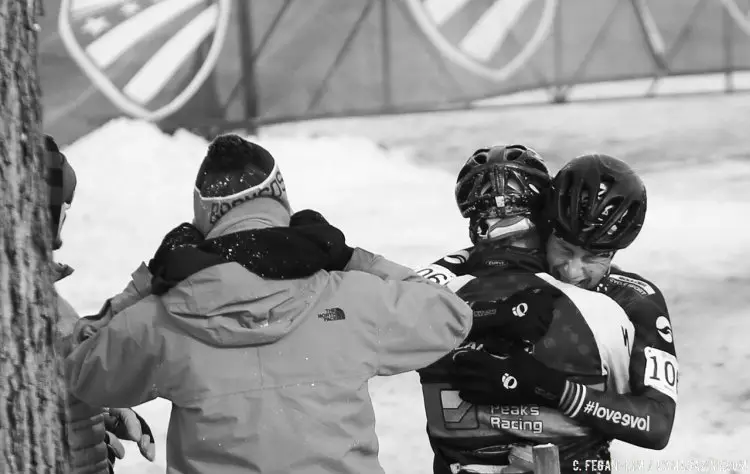
Heartbreak = Maxx Chance’s phenomenal race. 2017 Cyclocross National Championship, Men’s U23. © C. Fegan-Kim / Cyclocross Magazine
The Man with the Plan
The beneficiary of Chance’s misfortune was Lance Haidet. That is not to say that Haidet was a lucky, fluke winner. Haidet had a plan and he executed it flawlessly.
Haidet slowly worked his way from sixth to fifth to fourth, all the way to second after the rubbing-is-racing moment. Haidet took advantage of a Hecht bobble in the blacked out back half of the course and then when Chance’s chain dropped, he was in the perfect position to capitalize. For nearly 45 minutes, he had executed his plan perfectly before it paid off in the biggest way.
“The whole race my goal was to minimize my own errors and put myself in the position to capitalize when the opportunity came, which is exactly what happened,” he said. “Real bummer for Maxx, but it was definitely my plan just to be there and make the most of what happened late in the race.”
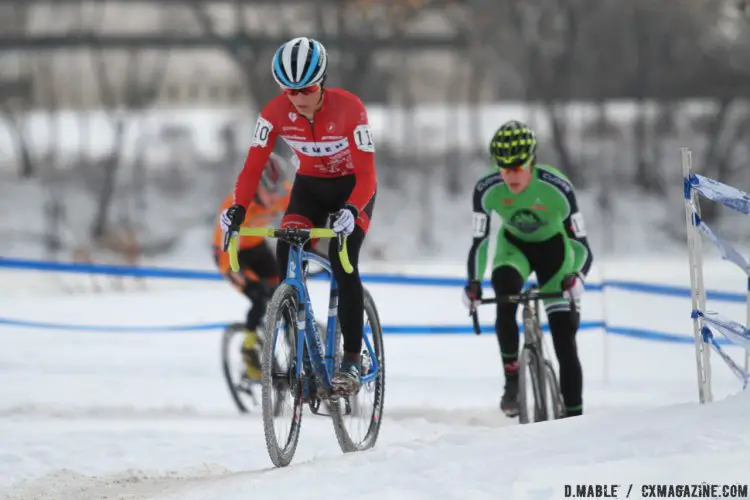
Lance Haidet’s patience paid off in Hartford. 2017 Cyclocross National Championships – U23 Men. © D. Mable / Cyclocross Magazine
Once he passed Chance, Haidet still had two tough technical sections to go and Hecht hot on his tail. Few of us will ever be in such a position, so what was going through Haidet’s mind?
“You have the race won, don’t screw it up,” he said. “That little off-camber section and the run-up and the off-camber after the run-up, it was pretty darn sketchy. There was a pretty good chance something could go wrong. At that point, I knew I had five or six seconds on Gage, and I knew I had a pretty good gap now on Maxx. For me, it was just trying to take it smooth and steady. I knew being one or two seconds slower here was better than crashing and getting third. There was a lot of that going through my mind.”
Haidet survived 20 seconds that probably felt like 20 years and emerged onto the finishing straight as the new U23 Men’s National Champion. It was a most improbable way of winning, but on the snowy, frozen, rutted course, slow and steady was the best way to win the race.
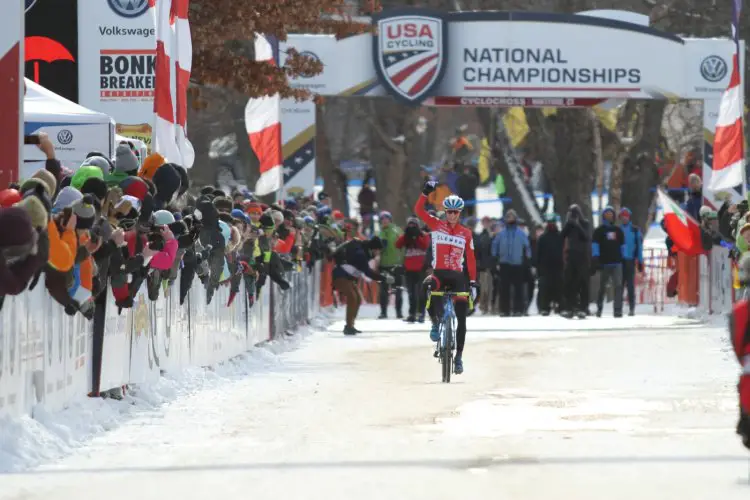
Haidet’s win was thrilling and somewhat improbable. Slow and steady won the race. 2017 Cyclocross National Championships – U23 Men. © Cyclocross Magazine
Looking back months later, Haidet was still a bit taken aback by what he did. “It’s so crazy looking back on it now that I won Nationals and led the race for literally like 20 seconds,” Haidet said. “When I finished the race, I really didn’t even know how to react. In the last half of the race, I went from fighting for the podium to winning. In the moment I wasn’t really thinking about that at all, it was just like ‘go as hard as you can and see what happens.’ And then afterward, it was like ‘I won.’ It’s hard to explain the shock to the system.”
At the time, here’s what Haidet had to say.
One Afternoon in Hartford
After everything that had changed at the front of the race, the final podium was Haidet, Hecht and Chance. The slow and steady Haidet had calmly rallied to take advantage of opportunity when it arose.
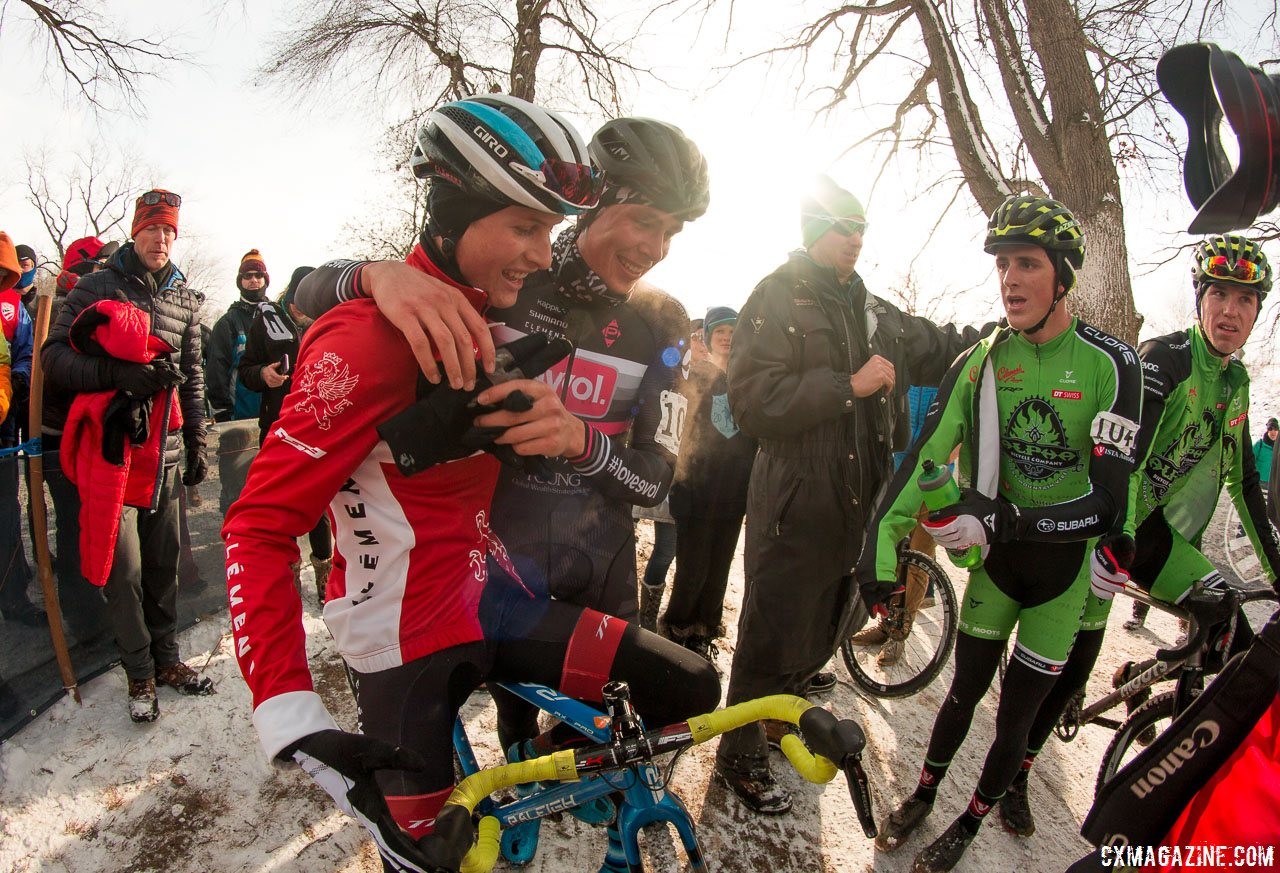
Sportmanship. Despite the heartbreaking event, Chance congratulates Haidet on his win. © Cyclocross Magazine
Both Chance and Haidet had career-defining rides that day and they were both rewarded for their efforts. In the year that has past since that January day, the biggest star in that field has been Hecht. Hecht has stared down Stephen Hyde and won going away at the Pan-American Championships.
He now heads to Reno as the odds-on favorite, in the same position as White a year earlier.
The story of 2018’s U23 Men’s race will be written next Sunday, but for those who watched, the 2017 U23 Men’s race at the Hartford Cyclocross National Championships is one to remember. The intensity of the racing, the treachery of the course and the sheer drama that unfolded in Hartford represented everything that is beautiful about cyclocross. For folks at home, it was all there, even if the race was left half-seen.
2017 U23 Men’s Hartford Nationals Replay
For coverage of this year’s Nationals, see our home page for comprehensive 2018 Reno Cyclocross Nationals coverage.























